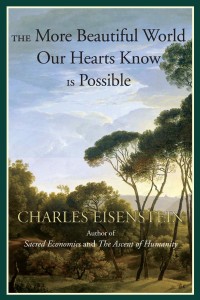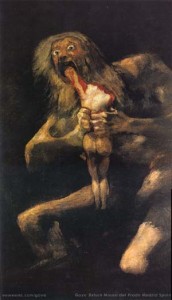
The book club here at Patheos provided me the opportunity to read and review a book entitled The More Beautiful World Our Hearts Know is Possible and I leaped at the opportunity to check out a text published in North Atlantic Book’s Sacred Activism series.
Having read it, I found it to be more than a simple collection of words and pages; it’s a disruptive phenomenon. And, like all disruptions, it takes time to fully understand them and their ramifications. Over the last few days as I read the book, I struggled with how I would review it because there’s a lot between its covers that we could talk about.
Charles Eisenstein organizes his book into three primary sections. First, he discusses the current story that we’re telling within our world, one that he describes as a story of separation. He does not use “story” in the way we usually do; it does not refer to a fictional tale or an account of some real world series of events. Instead, he uses the term to describe the overall narrative of our civilization and how this narrative dictates the roles that we play within that story.
This story of separation is one that has deep roots–he links it in some cases to the agricultural revolution identifying that time period as one of the earliest periods in which humans began to think of themselves as separate from nature. Eisenstein explains that this story of our separation, regardless of its beginning, led our civilization to eventually not only begin to master, to conquer, our environments, but actually makes that mastery (and eventual destruction) both rational and practical. After all, if we’re separate from it, destroying it shouldn’t bother us, right?
It should be noted that this book focuses primarily on a the story of Western civilization. In fact, Eisenstein touches on other civilizations and how their stories dictated different roles, but he recognizes that the march of Western powers throughout the world eclipsed, annexed, or ended many of these stories. Throughout the text, the ramifications of our actions towards these other cultures are discussed frankly in an attempt to recognize how our story led us perhaps inexorably into the atrocities of colonialism. These portions of the book are hard to read but necessary.
In contrast to this story of separation, Eisenstein shares with us his hopes for a more beautiful world; one in which we tell a story of interbeing. This story, unlike our current one, emphasizes the connections between each of us and between us and the world around us. Further, it presupposes that the our actions may have consequences beyond our ability to predict allowing us to put value on choices that our current story would see as impractical or even selfish.
The remaining portion of the introductory sections describe how our story of separation directs our lives in a variety of way. He discusses how it limits what choices seem appropriate to us and how it forces us to play a role relating more toward disciplined self-sacrifice than one that seeks to maximize our joy and pleasure. Throughout the text, he’s careful to counter arguments to his premises (e.g. if we’re seeking to maximize pleasure, might that not increase addiction?) and, if anything, these counter points are what feel most repetitive especially as we move through into the latter portions of the text.
After dealing with our current story and it’s effects on us, he begins to discuss how those effects manifest our world. How our story values doing over non-doing and focusing on mastery and conquest rather than understanding and cooperation. He even dovetails into a (perhaps overly) length discussion on psychopathy and how rather than evidence that his story of interbeing cannot possibly be true, the existence of psychopathic tendencies and the success that these patterns of behavior can bring us is a result of our separation and not an innate part of our human nature.
And, as you may expect, after dealing with these habits that arise from separation he begins to discus how we can disrupt that story and work to bring about the one of interbeing. Using examples from the Occupy movements to the street art of Banksy, he shares with us how those who already tell parts of the story of interbeing can seek to hold space for others and to help others transition as well.
As a Pagan, it was hard not to feel some measure of pride throughout the book. So many of the concepts of interbeing that Eisenstein shares with us felt very familiar to me. He even praises theological concepts of animism and panentheism–common threads in many Pagan tapestries–as providing models of interbeing from our ancestors. I kept waiting, hoping for the moment when he mentioned us but it never happened. After all, part of the story of separation is the unfulfilled need for validation, to feel as if were making the correct choices when others are not. The very pride I felt as I read the book is indicative that I still embody the habits of separation.
And, this is truly the disruptive power of the text: it acts as a mirror forcing us to see our selves in a new light and reevaluate choices we’ve made. Eisenstein regularly pauses his narrative to ask if the prior section made his reader uncomfortable or prideful or insecure. These portions of the book are not delivered with a sense of superiority, Eisenstein shares his own personal stories of mistakes and failures throughout. Instead, they seem more like a patient leader helping us to take the first few steps on a new and largely unfamiliar journey.
With ties to our current American political stagnation, our global economic woes, and even the dangers of climate change, Eisenstein’s narrative is a thorough exploration of where we are, what that means, and where we need to go if we’re going to change the direction of our world. With it, he has created a vehicle to empower others to understand themselves, to find their truth, and to begin to create that world he describes. Reading it presents our inner skeptical cynic many opportunities to ignore his narrative as naive and impractical. But, as he states in the text, we’re rapidly approaching a time when what’s practical, a description mired in the obsolescing story of separation, is itself, impractical, giving us the freedom to seek solutions that our hearts know are possible.















